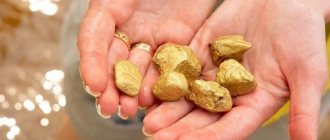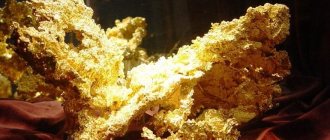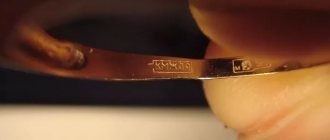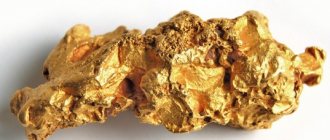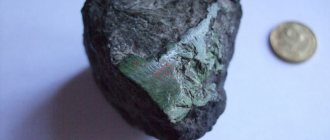Greetings! People have been trying to figure out the origin of gold since ancient times. First of all, those who wanted to quickly get rich were zealous, having learned, with the help of this knowledge, to extract precious metal from stones and garbage. Of course, they didn't succeed.
Scientists have achieved greater success - people driven by a passion for knowledge, and not by greed. Until now, no one has been able to turn stones and debris into gold under terrestrial conditions, but thanks to science we can imagine where it came from on our planet.
Dripping Pitch Experiment
They say that the glass slowly “drains” and over the centuries becomes a little thicker at the bottom of the window, distorting the appearance of antique stained glass windows. As for glass, this is just a legend, but some other materials that are considered solid actually flow.
In 1927, a professor at the Australian University of Queensland, Thomas Parnell, decided to demonstrate this using the example of pitch - a heavy sediment that remains after the distillation of tar and is used, for example, to make roofing felt. As this resinous mass hardens, it becomes hard enough to crack upon impact. And yet, it remains a liquid, although extremely viscous, and therefore capable of flowing. Just very, very slowly.
Having melted the pitch on the burner, Thomas Parnell poured it into a glass funnel with a sealed neck and left it to cool. In 1930, they fixed the funnel on a tripod, placed a glass under it, opened the neck and began to wait for the pitch to slowly flow down. The first drop fell after a little over eight years, when no one saw.
The University of Queensland - 1979: the ceremonial fall of the sixth drop of pitch
Pitch is extremely viscous—about 250 billion times higher than water—so the fall was unexpected. The drop formed at the neck for years and gradually stretched out until it broke away from the main mass in the funnel. Until the last moment everything happens as if in a slow motion movie. Very, very slow motion.
A drop of pitch takes years to stretch out, and can finally break off at any unpredictable moment over the course of many months. It is not surprising that Professor Parnell also did not catch the second drop that fell in 1947. A year later, at the age of 67, he died, and the keeper of the experiment turned out to be his student and like-minded person, John Mainstone. For many years he scrupulously recorded the fall of the drops, never seeing this wonderful moment. And those continued to appear at intervals of about eight years: 1954, 1962, 1970, 1979, 1988. But the next drop had to wait for 12 years, until November 2000.
John Mainstone, The University of Queensland - 1990: second keeper of the pitch John Mainstone awaiting the eighth drop
By this time, the webcam was already pointed at her, but an unforeseen fate acted, and at the right time the equipment did not work due to a sudden power outage. And scientists had to puzzle over why the eighth drop took so long to fall. The culprit was considered to be a recent renovation: after installing air conditioners, the air in the room became cooler, and the viscosity of the pitch decreased slightly. This is also indicated by the size of the drop, which turned out to be noticeably larger than the previous ones. The next, ninth drop was supposed to confirm or refute this hypothesis.
Like the eighth drop of pitch, the ninth had been “ripening” for more than 12 years and looked larger than the previous seven. It flowed slowly, touching the support before the bridge that connected the drop with the main mass of pitch in the funnel broke. It’s difficult to call it a fall: in fact, the drop only sharply changed its speed, slowing down its flow when the bulk of it was below. However, it attracted enormous attention, and more than 31 thousand curious volunteers watched the webcam broadcast. This time we managed to make a recording: the moment of a sharp change in speed was recorded on April 12, 2014. Of course, there was no one in the laboratory then.
By then Mainstone had already taken on assistant Andrew White, who was preparing to become the third keeper of the pitch. So that the next drop could fall fully and not drain like the previous ones, he decided to raise the funnel higher. On April 24, for the first time in many decades, he began to lift the glass cap. Unexpectedly, it turned out that it was glued to a wooden support and came off abruptly, shaking the entire experimental setup. So the ninth drop finally came off, and today we live in anticipation of the tenth.
Andrew Stephenson, The University of Queensland
Most likely, the tenth drop will fall in the coming years. Careful observations show that its volume increases by 19 cubic meters. millimeters per day. Based on this, White calculated the current viscosity of the pitch, which turned out to be only 30 billion times higher than that of water. Perhaps the decrease in viscosity is due to the installation of lighting in the laboratory, which began to work around the clock, illuminating the pitch for web cameras and at the same time heating the air. This means that the tenth drop will fall faster than the previous one - most likely around 2025.
The falling pitch experiment is listed in the Guinness Book of Records as the longest continuous laboratory experiment, and Mainstone and White (along with the late Parnell) were awarded the 2014 Ig Nobel Prize. Scientists are determined to catch that very moment when the tenth drop falls. Enthusiasts from all over the world are also preparing: a webcam is monitoring the baking, and tens of thousands of enthusiasts are again going to join the broadcast. This time the drop is unlikely to slip unnoticed by human eyes - unless the strange and evil fate that haunts this long-term experiment again intervenes.
How deposits are developed
Finding gold is very difficult; its extraction is an art. There are no special indicators that can accurately determine its presence in rocks. Therefore, when searching for gold, a thorough study of the area, a deep understanding of geology, observation, accumulated experience, knowledge of modern exploration methods and, of course, intuition are required.
Along with the exploration of mineral territories, special attention must be paid to the percentage of gold in the total mass of ore in order to understand the economic efficiency of the developed deposit. Profitability will be fully justified if its satellites, other minerals, are mined with gold.
Assessing the world's current gold reserves requires a global approach. This means taking various rock samples, carrying out repeated calculations regarding the profitability of gold mining, and performing drilling and geological exploration work on a significant scale.
Here is an example of preparing a field for production:
- primary reconnaissance, covering the search and assessment of lands, as well as establishing the order of their transfer in subsequent preparatory phases;
- target survey to delineate the mine boundaries;
- preliminary engineering work;
- taking metallurgical samples;
- carrying out economic calculations and methods of probable analysis;
- rental or acquisition of land plots with fossil gold;
- preparatory work for the transfer of the deposit to industrial development using complex, state-of-the-art equipment.
Upon completion of exploration and preparation of the deposit for industrial work, the construction of a gold mining enterprise begins. The construction of a modern gold mine can cost half a million dollars, taking into account capital costs and the number of employees, the number of which ranges from 15-20 thousand people.
The annual gross output of the newly formed enterprise is approximately 40 tons of metal, which in monetary terms is equivalent to 500 million dollars.
Oxford electric bell
The quiet ringing in the corridor of the Clarendon Laboratory in Oxford has not ceased since 1840. Covered in a glass bulb, there is a bell that was made back in 1825, and then ended up in the collection of electrical devices collected by physics professor Robert Walker. A 4mm ball is hit between a pair of oppositely charged metal bells: touching one, it receives part of its charge and begins to push off, hitting the opposite one. The process is repeated at a frequency of 2 Hz and will continue until the charges on the bells are completely balanced.
Photo of a bell, 2009
Metal nuggets
Gold occurs in nature in the form of nuggets. The photo of the most famous finds shows that large natural pieces of precious metal are usually called nuggets. Most of these incredible finds were made during the search for the yellow metal, although there were also accidental discoveries. Today, experts recognize a nugget as a piece of gold whose weight exceeds 5-12 g and whose cross-section is more than half a centimeter.
The most famous metal nuggets weigh several tens of kilograms. The largest nugget in the history of mankind is a piece of gold found in the 11th century in the southern regions of Afghanistan. According to the description that has survived to this day, it was supposed to weigh approximately 2.5 tons.
What does native gold look like in nature? Look at the photos of the most famous nuggets, among which you can note the “Holtermann Plate” (100 kg), “Welcome Stranger” (71 kg) and “Brilliant Barkley” (54 kg) found in Australia, and “Japanese” (71 kg) from the island of Hokkaido. The history of gold mining also includes finds from Russian deposits: “Big Triangle” (36 kg, Ural), “Bolshoy Tyelginsky” (14 kg, Chelyabinsk region), “Golden Giant” (14 kg, Magadan region), “Pokhod im. Kalinina" (14 kg, Ural), "Aprelsky" (12.24 kg, Lena mines).
"Holtermann Plate".
Beverly watch
Made by New Zealand master Arthur Beverley, the clock has been running since 1864, although it has never been wound since then. They are nourished by natural daily fluctuations in temperature and humidity. The watch has a sealed air container built into it, which elastically deforms, automatically lifting the weight that rotates the wheels of the clock mechanism. A typical difference of 3.3°C is enough to lift a pound weight an inch, storing 13 mJ of energy for the next 24 hours.
Watches that operate on this principle can now be purchased for yourself; they are manufactured by the Jaeger-LeCoultre manufactory. Well, that same Beverly Clock can be seen on the third floor of the Faculty of Physics at the University of Otago in New Zealand.
Metallogenic eras
Before considering aurogenic epochs, let's look at the epochs of general metallogenesis (age is given in million years):
- Vendian
(570-610) [close zircon peaks: 142, 300, 370, 425, 642]. Then a pause of about 400 million years [until the end of the Mesozoic and the beginning of the Cenozoic?]. - Middle Riphean
(1000-1350) [zircon peaks: 920, 1100, 1250]. - Early Riphean
(1350-1650) [zircon peaks: 1550]. - Svecofennian
(1650-2100): Svecofennian (
Vepsian
: 1650-1800) [zircon peaks: 1750]. - Svecofennian ( Calevian
: 1800-1920) [zircon peaks: 1950]. - Svecofennian ( Ludicovian
: 1920-2100) [zircon peaks: 2130].
(2400-2500). Before this there is a pause of 300 million years.
(2500-2800) [zircon peaks: 2650 (middle), 2730].
(2800-3000) [zircon peaks: 2900 (middle)].
At Voitekhovskaya
a number of gold mining epochs are noted, among which
the Late Archean
(2.9-2.6 billion years ago) [Late Lopian era], represented by deposits of
the Witwatersrand
(South Africa),
Kalgoorlie
(Western Australia),
Hemlo
,
Yellowknife
, and characterized by the widespread development of active volcanic and post-volcanic processes, stands out .
This is followed by maxima of 1.7-1.6 [end of Svecofennian], 0.8, 0.4-0.24 and 0.2-0.01 billion years ago. The Paleozoic
and
Meso-Cenozoic
maximums mean a new activation of the gold mining process. Moreover, the periodicity of gold mineralization maxima approaches the periodicity of orogenic endings in the tectonic history of the Earth.
Broadbolk experiment
British Rothamsted Research is one of the oldest agrotechnical institutes in the world. It opened in 1843 as an experimental station, which immediately began a long-term research project. Initially, here, in the Broadbalk field, they tested how different fertilizers affected the yield of winter wheat, and planned to complete the work by 1841. But over time, the task became much broader, and to this day, wheat is grown year after year on the same field in Hertfordshire, England, studying the influence of a variety of factors on its growth, testing new fertilizers and pesticides. The care and patience of local biologists can be envied: for example, they spent a whole year assessing how different numbers of worms in the soil would affect the harvest.
In industry
The special properties of the metal have given it special significance in industry. It is used:
- in the transport industry;
- in energy;
- in the chemical industry;
- in telecommunications;
- in nanotechnology;
- aviation;
- in the space industry.
For medicinal purposes, gold is also of great importance. It is used for dental work, for rejuvenation and for the treatment of certain diseases, such as:
- colds;
- heart disease;
- diseases of the nervous system;
- development of atherosclerosis.
Grant review
Psychologists at Harvard Medical School launched the Grant Study back in 1938. This is a longitudinal - that is, extended over time - study dedicated to finding the factors that determine happiness, satisfaction and success in life. Scientists selected 268 Harvard students and have since been interviewing them in detail from time to time, trying to assess the course of life from different angles. As part of a similar project, the Glueck Study, ordinary residents of Boston were simultaneously studied, 456 people who did not belong to the elite cohort studying at a prestigious university.
The collected data formed the basis of dozens of scientific articles. Among other things, scientists have found that a key factor that determines a happy life is quality human relationships with family, friends and neighbors. But money, social status and fame have a rather insignificant effect on the level of personal happiness. Interviewing of the surviving project participants is still ongoing. The following generations take the place of the departed: as part of a related experiment, G2, psychologists follow the lives of the children and grandchildren of their first volunteers.
Metal prevalence
Gold as a chemical element is found everywhere. The opinion that precious metal can only be found on the territory of deposits is incorrect. Gold is found in atomized form in plants and animals, as well as in the human body. The presence of metal in these cases can only be determined using special analytical methods. Gold is naturally found in the waters of the World Ocean; its concentration per ton of water ranges from 4 to 10 mg. This indicator is good, but there are currently no effective methods for extracting metal from the waters of the World Ocean.
The average content of the yellow metal in the crust of our planet does not exceed one millionth of a percent, so the threshold for the concentration of gold in the main rock, which allows us to consider a certain area a deposit, is also very low. Sometimes even a ratio of a quarter of a gram of precious metal per ton of rock may be considered beneficial for starting gold mining in that location.
The gold standard: a brief historical excursion
The gold standard is an accepted system according to which the value of money is equivalent to a certain amount of gold. Initially, the silver standard was adopted. But later the silver was replaced.
This approach had many advantages:
- durability of the metal and its immutability;
- good divisibility;
- high level of cost;
- characteristic differences from other metals.
One of the principles of the gold standard is that any money can be quickly exchanged for gold. This is a guarantee of no inflation.
This model first appeared in England at the beginning of the 19th century. And the pound had the status of a currency recognized throughout the world for a long time - until 1914. During the Bretton Woods Conference, this standard was legalized.
At the end of the 20th century, America abandoned this system. And after some time, the standard ceased to be used at all. This happened for several reasons:
- Difficulty moving large amounts of money.
- Difficulty in issuing.
- Possibility of resource loss.
Since the present time is characterized by many financial crises, economists have proposed returning to the standard. However, gold reserves are too small for this. And they are unable to ensure full monetary circulation.
